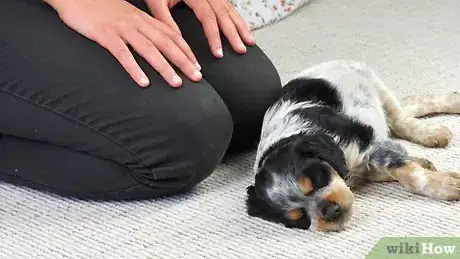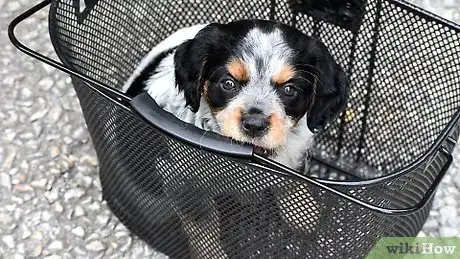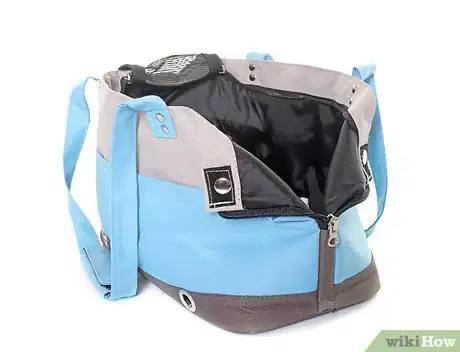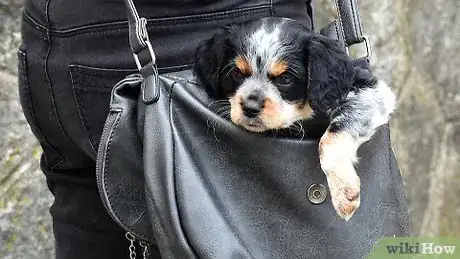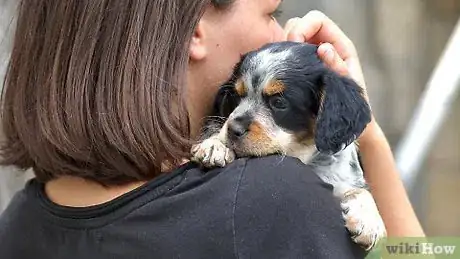This article was co-authored by Deanne Pawlisch, CVT, MA. Deanne Pawlisch is a Certified Veterinary Technician, who does corporate training for veterinary practices and has taught at the NAVTA-approved Veterinary Assistant Program at the Harper College in Illinois and in 2011 was elected to the board of the Veterinary Emergency and Critical Care Foundation. Deanne has been a Board Member of the Veterinary Emergency and Critical Care Foundation in San Antonio, Texas since 2011. She holds a BS in Anthropology from Loyola University and an MA in Anthropology from Northern Illinois University.
There are 12 references cited in this article, which can be found at the bottom of the page.
This article has been viewed 81,601 times.
It is a good idea to socialize your puppy by carrying them when out in public and while in your own home. But, puppies can also be squirmy little bundles. To properly carry your puppy you will want to get down low, secure a handhold, and lift it slowly. You can also use a basket or backpack to hold the puppy as you move around. It is important to remain calm when holding a puppy as it will take its behavioral cues from you.
Steps
Completing a Successful Pick-Up and Carry
-
1Bend down to the puppy’s level. Approach the puppy from the side of their body, so that you don’t pose a head-to-head threat. Slowly bend your knees to the ground or lower yourself into a squat when you are near the puppy. Hold a few moments in this position with your hand extended to let the puppy sniff you a bit.[1]
- If the puppy acts agitated at this point by growling or attempting to bite, you may want to wait a few minutes and then approach again.
-
2Place 1 hand under the puppy's bottom. Gently slide one hand around the rear area and under the tail of the puppy. You want the puppy’s behind to rest firmly on your forearm and hand. It is important that you place both hands on the puppy at the same time. Move in a deliberate and efficient way.[2]Advertisement
-
3Place 1 hand under the puppy's chest. At the same time, slide your other hand across the puppy’s chest to support its back and front body. If the puppy is squirming a bit you can also move your hand into the space between its front legs and use your forearm to help with the holding as well. If you do this, slide your other arm further around the rear to provide a counterbalance on the outside of the puppy’s body.[3]
- Most people prefer to carry using their dominant arm and hand to hold the front part of the puppy. This can give you better control over the head area too.
-
4Rise up slowly to a standing position. Push up from your knees at a snail’s pace. Moving too fast at this point can startle the puppy. As your rise, pull your puppy’s body towards you until there is no space between you. Cradling it against your body will have the effect of adding even more stability (and a sense of comfort for the puppy too).[4]
- As you start to walk, keep the place slow as well and try not to multitask while holding the puppy. You don’t want to run the risk of dropping it while you are distracted.
-
5Speak in soothing tones and verbally praise the puppy. It may be helpful to say positive, calming statements in a soothing tone throughout this process. Dogs and puppies often respond positively to their owner’s voice, in particular. You might say, “Good girl,” or, “Be calm.”
-
6Avoid picking the puppy up by the scruff. In the past, many people would pick up a puppy by grabbing a handhold of neck-scruff and lifting. This practice has gone by the wayside as it can be potentially harmful to a puppy. Do not “shake” or “alpha roll” your puppy with their scruff to ensure submission, as you can hurt the puppy or it may bite you. This also damages the animal-human bond between the two of you.
- Do not pick your puppy up by the forelegs either. This offers no spine support and can contribute to a host of health problems for those breeds that suffer from genetic joint problems.[5]
-
7Expect the puppy to go limp. As you lift and carry your puppy you may observe that it goes almost completely limp, relaxing its body against yours. This is a good thing and is part of the natural process. The puppy may assume that you are protecting it in some way and doesn’t want to inhibit your progress by squirming.[6]
-
8Release the puppy if you feel resistance. If the opposite occurs and your puppy acts agitated try to calm it for a few seconds and then gently bend back down toward the floor. When you are close to floor level slowly set the puppy down so that it stands upright.[7]
Carrying with a Container
-
1Place the puppy in a small basket for rides or walks. Many people will use a modified basket to carry their puppies as they ride on a bike or take a brief walk. Just make sure that the basket isn’t too large and that the puppy can reach its head out for air and to look around. Practice with your puppy at home before taking basket-riding public.[8]
- It is best if you buy a basket specifically designed to carry an animal. These will often come with some sort of safety leash or instructions regarding safe use.
-
2Put the puppy into a dog sling to keep it close to you. This is a piece of fabric that you position and wrap across your body. You then place the puppy within the fabric in front of you with its head peeking out. The way that you wrap the fabric around your body provides a tightness that will then serve to support and hold the rest of your puppy’s body.[9]
- These can be purchased in pet stores and look very much like slings used to hold babies. In fact, some people say that you can use baby slings to hold puppies--just be very careful to watch for head clearance.
-
3Use a dog backpack to carry the puppy on your back. A dog backpack is exactly what it sounds like, although they can come with a variety of modifications. Look for a backpack that is the most comfortable for you both. It needs to be adjustable so that you puppy won’t sink down in it and lose airspace. It should also be at least partially machine washable.[10]
- One drawback to using a dog backpack is that you lose visibility of your puppy while they are on your back. You can remedy this by wearing the backpack on your chest instead. Or, you can wait until your puppy is large enough to see if you turn your head around while wearing the backpack.
-
4Place the puppy into a travel carrier on long trips. If you will be carrying your puppy onto a plane, train, or other moving vehicle you may want to use a soft-sided travel carrier. This carrier will give your puppy a bit of room while providing protection at the same time.[11]
- Check the airline's website for exact size requirements and restrictions regarding pet carrying cases.
-
5Avoid using makeshift carriers to prevent injuries. If you have a small puppy it may be tempting to simply place it in your purse and go, but that can be quite dangerous. Your puppy can suffocate or ingest dangerous materials while sitting in your purse. Puppies can also simply fall (or jump) out of makeshift carriers.
-
6Make time for regular bathroom breaks. If you choose to carry your puppy in a carrier, be aware that it is only a matter of time before it will need to use the restroom. You can get a general estimate as to how long your puppy can wait by adding a 1 onto their age. So, a 4-month-old puppy could probably wait for five hours, although a quicker break would be better.[12]
Considering the Benefits of Carrying
-
1Fulfill the parental role by carrying your puppy. While your dog is small, it will expect its owners to take on the role of “mom.” This means giving affection and discipline, but also protection. When a puppy is picked up it often assumes that a danger is nearby and that you are taking it to a safer place. So, picking up and carrying your puppy is an expected and important part of their development.[13]
-
2Enhance your puppy's socialization through touch and carrying. Holding your puppy is also a good way to increase its ability to tolerate and enjoy social interactions. Puppies have a window for social development that closes when they turn 14 weeks old, so it is critical that they are handled a great deal early on in their lives. Puppies that aren’t socialized properly can turn into aggressive and fearful adult dogs.[14]
- To get the benefit of socialization, however, you must handle the puppy gently and create a positive memory of human interaction.[15]
- Getting a puppy used to being carried will make the process smoother and less stressful in the event of an emergency in which you must pick up the dog.
-
3Protect your puppy from disease. Carrying your puppy is also a way to take it into public in the early months of its life before it is fully protected with vaccinations. Many vets will suggest that you either keep your puppy indoors prior to vaccinations or your carry it everywhere. The reason for this, in part, is that viruses, such as the parvovirus, can be picked up on the ground by unsuspecting puppies.[16]
- The parvovirus is often spread through contact with the feces from an infected animal, which a puppy can encounter while playing on the ground in a variety of locations.
-
4Prevent your puppy from becoming exhausted. Puppies simply don’t need to be exercised the way that adult dogs do. Making a puppy walk for longer than 5 minutes or so can actually be harmful to the development of their bones. If you want to walk around the neighborhood, carry your puppy for at least part of the way.[17]
-
5Use carrying as a puppy selection tool. It is very controversial, but some breeders and dog owners still use a puppy’s reaction to various holding positions to determine their final temperament. You can often judge if a puppy is more laid back by how they respond to your carrying attempts, but forcibly cradling a dog to watch for signs of acceptance (also known as the “cradling test”) is not a good idea. It can ruin the trust between a puppy and owner and make a puppy fearful.[18]
Warnings
- Be gentle when holding your puppy and make sure that your hold is not too tight.⧼thumbs_response⧽
- Don’t let young children hold and interact with your puppy in an unsupervised way. This can lead to your puppy’s injury or even death. Your puppy might also bite or scratch a child out of fear.⧼thumbs_response⧽
- When you are walking around carrying your puppy never set it down on a high location, such as a table, even for a moment. The puppy could accidentally fall off and break a bone or worse.⧼thumbs_response⧽
- Do not punish your puppy if they squirm while you are holding them or if they resist your hold entirely. Punishment can socialize a puppy to be violent. Instead, use positive reinforcement.[20]⧼thumbs_response⧽
References
- ↑ https://pethelpful.com/dogs/Why-is-My-Dog-Growling-When-I-Pick-Him-Up
- ↑ http://www.aspca.org/pet-care/dog-care/general-dog-care
- ↑ http://www.dogtrainingnation.com/dog-safety-tips/how-to-safely-lift-and-hold-a-small-dog/
- ↑ http://www.dogtrainingnation.com/dog-safety-tips/how-to-safely-lift-and-hold-a-small-dog/
- ↑ https://pethelpful.com/dogs/Why-is-My-Dog-Growling-When-I-Pick-Him-Up
- ↑ https://www.psychologytoday.com/blog/canine-corner/201201/why-do-some-puppies-go-limp-when-you-lift-them
- ↑ http://www.petplace.com/article/dogs/keeping-your-dog-healthy/puppy-care/how-to-talk--to-and-handle-my-new-puppy
- ↑ https://averagejoecyclist.com/best-way-carry-dog-on-bike-pet-bike-basket/
- ↑ http://topdogtips.com/dog-backpack-or-carrier-sling/
- ↑ http://dogsaholic.com/lifestyle/backpack-to-carry-dogs.html
- ↑ http://www.humanesociety.org/animals/resources/tips/traveling_tips_pets_ships_planes_trains.html
- ↑ http://www.petplace.com/article/dogs/keeping-your-dog-healthy/puppy-care/what-not-to-do-with-your-new-puppy
- ↑ https://www.psychologytoday.com/blog/canine-corner/201201/why-do-some-puppies-go-limp-when-you-lift-them
- ↑ http://www.thelabradorsite.com/when-can-i-take-my-puppy-out/
- ↑ http://www.petplace.com/article/dogs/keeping-your-dog-healthy/puppy-care/how-to-talk--to-and-handle-my-new-puppy
- ↑ http://www.thelabradorsite.com/when-can-i-take-my-puppy-out/
- ↑ http://www.thelabradorsite.com/when-can-i-take-my-puppy-out/
- ↑ https://thecaninetrainingcenter.com/how-to-pick-a-puppy-or-dog-part-one/
- ↑ http://www.petplace.com/article/dogs/keeping-your-dog-healthy/puppy-care/what-not-to-do-with-your-new-puppy
- ↑ http://www.petplace.com/article/dogs/keeping-your-dog-healthy/puppy-care/what-not-to-do-with-your-new-puppy
About This Article
To carry a puppy, start by bending down to the puppy’s level, putting 1 hand under its bottom and the other hand under its chest, and rising slowly to a standing position. If the puppy seems agitated, speak in soothing tones and verbally praise it. Don't be alarmed if the puppy goes limp in your arms, which is actually a sign that it's relaxed. However, if the puppy won’t stop wiggling, then gently bend down and release the puppy to the floor. For more tips from our Veterinarian reviewer, including how to carry a puppy in a backpack, keep reading!
